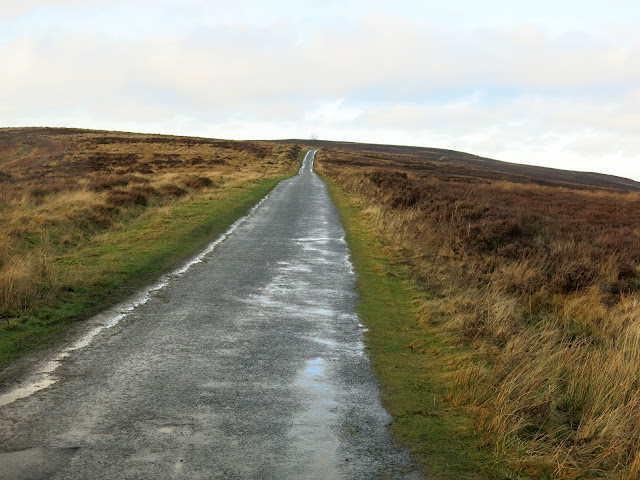The Hanging Stone and High Cliff from Gribdale Gate
8 miles Cold and wet
Today's weather forecast was for a sunny day so we expected some good views on this walk, which we haven't done for a couple of years. The weather forecast was wrong.
We parked at Gribdale Gate and followed the footpath steeply uphill and onto Great Ayton Moor as it started to rain. In The Walker's Guide to the Cleveland Hills, Tom Scott Burns relates a curious belief from a 19th century book called 'Customs of North Riding' which states, 'Anyone who dares to stand near Gribdale Gate at midnight on New Year's Eve will see an old man pass through the gate and vanish'. New Year's Eve is still more than a week away so we should be OK today.
 |
| Today's walk from The Walker's Guide to the Cleveland Hills |
 |
| Sharp climb to Great Ayton Moor |
 |
| On Great Ayton Moor |
|
After reaching the moor the footpath
followed a dry stone wall with views over to Roseberry
Topping which was brightly lit against a stormy sky. We came to a gate at Newton Moor
but turned right just before it. Tom Scott Burns mentions that this is
the site of a chambered cairn, part of a complex Neolithic burial site
dating from the Bronze Age, roughly 2300 - 800BC, a time when these
moors were covered with mixed forest and woodland clearance was
beginning to take place. By the Iron Age the site was treeless and
cultivation was in progress. Following the Iron Age, heather had spread
across the moor replacing farmland, so the moors have in fact looked
much as they do now since that time.
After turning right at the gate we followed the moor track through
the remains of a conifer wood which TSB describes as 'a corridor of
trees rinsed with the scent of pine.' No more, I'm afraid those trees
have gone, like so many more, to the wood burning biomass furnace of the
power station.
 |
| Remains of a 'corridor of trees' with High Cliff in the background. |
 |
| The rain gets heavier.. |
The path eventually led us to a surprise view of Hanging Stone, which is a massive block of dandstone which TSB believes may have been part of an old quarry. We needed to pick our steps with care as we descended past the stone as the heavy rain was now starting to make the path slippery.
 |
| Approaching Hanging Stone |
 |
| Descending with care |
 |
| A long steep descent... |
 |
| ... to Hutton Lowcross Woods |
We took our time descending though the trees to briefly join a connecting track through Hutton Lowcross Woods, then turning left and descending again to reach Hutton village road. Turning right to walk along the road we entered Hutton Village which was built as a model village during ironstone mining in the 1850s. At the end of the village we passed a modern 'eco house' which was being built last time we passed by. We went through a gate and started to climb to Bold Venture Gill, a name that surely has a mining history.
 |
| Entering Hutton Village |
 |
| Our path lies through the gate ahead, past the eco-house |
 |
| Once miners' cottages and now desirable homes |
We stayed on this track ignoring all turn-offs and once again were surprised at the amount of tree felling. No longer 'endless rows of conifers' as described in The Walker's Guide to the Cleveland Hills. A convenient bench near to the nab was too exposed for our coffee stop so we continued under the nab on to Guisborough Moor, where we hunkered down behind a dry stone wall that sheltered us from the wind, if not the rain. Hot coffee and scones were very welcome.
 |
| Climbing towards High Cliff Nab |
 |
| High Cliff Nab |
 |
| We walk along by the nab to find.... |
 |
| ... shelter behind a dry stone wall |
 |
| Setting off after coffee | |
|
 |
| Lonsdale Bowl as the sun breaks through |
 |
| Looking back to Lonsdale Bowl |
We were now on our final leg of the walk and we swung away from Percy Cross Rigg to drop gradually back to Gribdale Gate and our car.
 |
| Captain Cook's Monument appears on the far horizon |
 |
| Dropping back to our car |
We drove back to Great Ayton where I took a snap of a ringed gull sitting on Captain Cook's statue, unconcerned by our presence. After admiring a Remembrance Day display on the Green we adjourned for a pint in the Royal Oak. Returning to the car half an hour later we were surprised to see the gull still in the same position.
 |
| Little respect for the Captain |

















































No comments:
Post a Comment